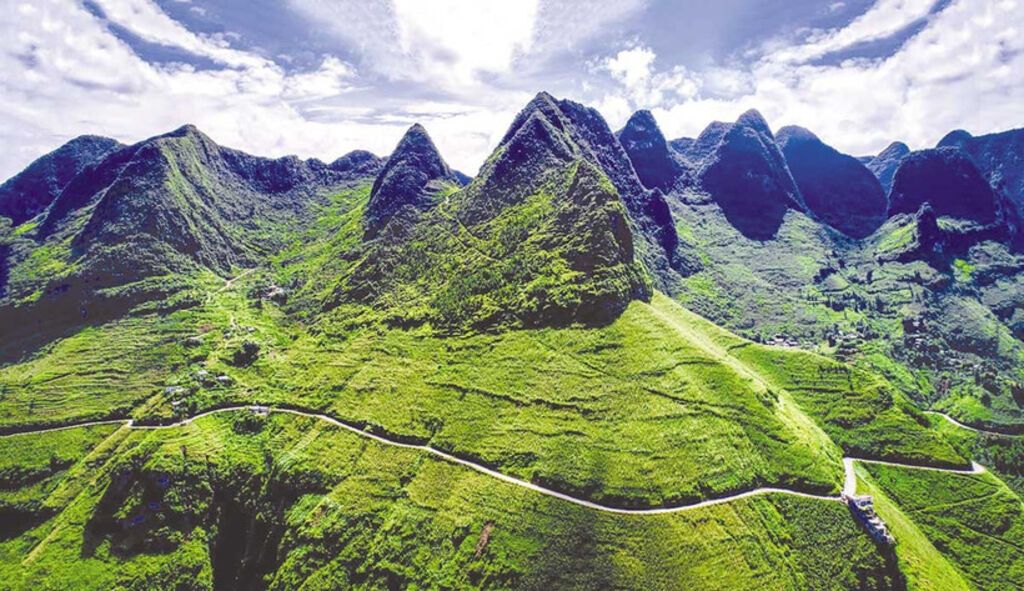 |
| A view of Ma Pi Leng Pass located in Dong Van Karst Plateau Global Geopark__Photo: baodautu.vn |
Thanks to efforts of local communities and more structured capital inflows, tourism development is emerging as a new growth driver for remote and mountainous areas where indigenous experiences have become a key asset.
Investment flows revitalize mountain tourism
Following a subdued period in 2024 due to natural disasters, tourism in many upland localities has rebounded.
The Dong Van Karst Plateau Global Geopark in Tuyen Quang province was named Asia’s Leading Cultural Destination at the World Travel Awards 2025, providing a major boost to northern mountain tourism. Earlier, the former Ha Giang province, now part of Tuyen Quang, won Asia’s Leading Emerging Tourism Destination (2023) and Asia’s Leading Cultural Destination (2024). These titles, together with administrative boundary adjustments, are helping shape Tuyen Quang as the “heart of cultural and experiential tourism” of the region.
International awards are seen as a guarantee of credibility and long-term investment potential. As destination brands strengthen, investors have more confidence to commit capital, authorities have grounds to prioritize infrastructure, and communities are encouraged to preserve cultural identity and enhance services.
Tourism investment now focuses more on enhancing experiences, upgrading infrastructure, and developing skills for local communities. Projects only generate sustainable development when investment is tied closely to local life and livelihoods.
The UNESCO-recognized Dong Van Karst Plateau Geopark is viewed as a model of balancing conservation with authentic cultural experiences.
According to Hoang Xuan Don, Director of the Management Board, the area maintains its ethnic identity through everyday life rather than staged displays. Investment, he noted, should allow culture to “continue breathing” through training in professional tourism services and preserving traditional lifestyles - key elements that draw visitors back.
After the natural disasters in 2024, many businesses supported local communities through charitable tourism programs. Travellers combined exploration with contributions, such as donating school supplies, purchasing OCOP products, and using local services. Each homestay, woven item, and local meal created sustainable micro-investments that supported local livelihoods.
When authorities, schools, social organizations and travel companies coordinated their efforts, assistance became more effective, avoiding fragmentation. This approach was not only humanitarian but also a simple and scalable model of sustainable social investment, helping local communities build confidence and turn tourism into a bridge between goodwill and development.
Infrastructure, tourism skills, and cultural identity – key to tourism growth
As recognition and capital flow into upland destinations, the key question is how investment is used to generate real value. In mountainous areas, where conditions remain challenging, tourism development relies on practical improvements rather than large-scale constructions.
Priority is given to visitor infrastructure, including widened access roads, compact parking areas, safe viewpoints, bilingual signage, Wi-Fi coverage and standardized waste and wastewater treatment to protect the environment.
Equally important is “soft infrastructure”. Homestay owners join training on hygiene, cuisine and safety, intercultural communication for international guests, OCOP products receive support in packaging and traceability, and local youth are guided in digital storytelling to promote regional products.
Developing diverse experiences is another focus. Visitors can trek, ride motorbikes along the “Ha Giang Loop” (now within Tuyen Quang), explore caves, join evening cultural activities or attend workshops on traditional crafts. Each activity conveys local stories, allowing travellers to immerse themselves in culture.
Sustainable development also requires effective destination management, including safety and hygiene indicators, benefit-sharing mechanisms and a cultural preservation fund supported by accommodation revenue, entrance fees and experience services.- (VNA/VLLF)









